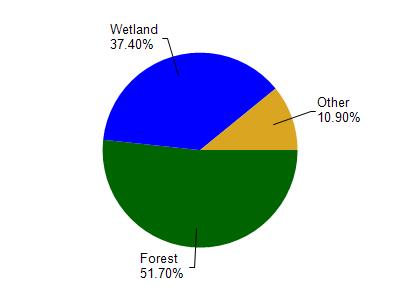Price
No
No
No
Fish and Aquatic Life
Overview
Murphy Lake, in the Elk River Watershed, is a 24.38 acre lake that falls in Price County. This lake is managed for fishing and swimming and is currently not considered impaired.
Date 2011
Author Aquatic Biologist
Historical Description
Source: 1983, Surface Water Resources of Price County
Murphy Lake T37N, RIE, Sec. 25.
Surface area 24.4 acres, maximum depth = 8 ft, MPA = 35 ppm,
Secchi disk = 3 ft.
A soft water, drainage lake, Murphy Lake is the headwaters of
Foytik Creek and has an outlet flow of 2.0 ft(3) /sec. It has one
tributary stream feeding the southeast corner of the lake.
Pumpkinseeds, black bullheads, white suckers and a few brook trout
comprise the fishery.
Tag alder swamps cover 50% of the shoreline, with 20%
tamarack -leatherleaf bog and 30% cleared field. Gravel is 10% of
the littoral zone and muck and detritus make up the remainder.
Emergent, submergent and floating vegetation are common throughout
the lake. Furbearer use is small, but mallards, wood ducks and
hooded mergansers nest here.
The only private development is a trail to the lake's north
side. There is no public frontage or access road.
Date 1983
Author Surface Water Inventory Of Wisconsin
Condition
Wisconsin has over 84,000 miles of streams, 15,000 lakes and milllions of acres of wetlands. Assessing the condition of this vast amount of water is challenging. The state's water monitoring program uses a media-based, cross-program approach to analyze water condition. An updated monitoring strategy (2015-2020) is now available. Compliance with Clean Water Act fishable, swimmable standards are located in the Executive Summary of Water Condition in 2018. See also the 'monitoring and projects' tab.
Reports
Management Goals
Wisconsin's Water Quality Standards provide qualitative and quantitative goals for waters that are protective of Fishable, Swimmable conditions [Learn more]. Waters that do not meet water quality standards are considered impaired and restoration actions are planned and carried out until the water is once again fishable and swimmable
Management goals can include creation or implementation of a Total Maximum Daily Load analysis, a Nine Key Element Plan, or other restoration work, education and outreach and more. If specific recommendations exist for this water, they will be displayed below online.
Monitoring
Monitoring the condition of a river, stream, or lake includes gathering physical, chemical, biological, and habitat data. Comprehensive studies often gather all these parameters in great detail, while lighter assessment events will involve sampling physical, chemical and biological data such as macroinvertebrates. Aquatic macroinvertebrates and fish communities integrate watershed or catchment condition, providing great insight into overall ecosystem health. Chemical and habitat parameters tell researchers more about human induced problems including contaminated runoff, point source dischargers, or habitat issues that foster or limit the potential of aquatic communities to thrive in a given area. Wisconsin's Water Monitoring Strategy was recenty updated.
Grants and Management Projects
| Project Name (Click for Details) | Year Started |
|---|
|
|
Monitoring Projects
| WBIC | Official Waterbody Name | Station ID | Station Name | Earliest Fieldwork Date | Latest Fieldwork Date | View Station | View Data |
|---|
| 2241500 | Murphy Lake | 10005209 | Murphy Lake | 8/29/2000 | 8/17/2013 | Map | Data |
|

Watershed Characteristics
Murphy Lake is located in the Elk River watershed which is 261.12 mi². Land use in the watershed is primarily forest (51.70%), wetland (37.40%) and a mix of grassland (4.70%) and other uses (6.20%). This watershed has 254.00 stream miles, 2,883.84 lake acres and 49,382.72 wetland acres.
Nonpoint Source Characteristics
This watershed is ranked Not Ranked for runoff impacts on streams, Low for runoff impacts on lakes and Low for runoff impacts on groundwater and therefore has an overall rank of Low. This value can be used in ranking the watershed or individual waterbodies for grant funding under state and county programs.However, all waters are affected by diffuse pollutant sources regardless of initial water quality. Applications for specific runoff projects under state or county grant programs may be pursued. For more information, go to surface water program grants.